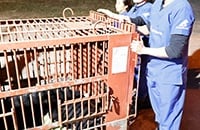How traumatised bear Kay has learned to trust again
18 May 2016
Kay was one of the most damaged bears that Animals Asia rescued in 2015 – but with the help of the Trust Technique, she is learning how to be a bear again.
James French and Shelley Slingo came to Animals Asia’s Vietnam sanctuary in January 2016 to teach the staff their mindfulness-based healing technique and work with our most traumatised bears. And the difference they made in 11 days has been amazing to watch.
The Trust Technique is based on two concepts. The first is – animals and humans share feelings. The Trust Technique understands animals are sensitive to how people are feeling, and can be reactive to these influences.
The second part is based on peace of mind in the present moment, which is helpful for both animals and people to achieve an authentic state of being.
James explained:
“By approaching an animal with a clear mind, the animals we work with naturally reflect that peace of mind. Often people approach animals with expectations they can’t understand, which leads them to become anxious.
“When people enter this state of non-thinking, they can fall asleep – and it’s the same for trusting animals. But when animals have been abused, they have to let go of their insecurities first. By giving traumatised animals a sense of peace, they’re given a safe environment to begin letting go of a lifetime of fear.”
One of the bears that James worked with was Kay. One of 33 bears rescued by Animals Asia from Vietnam’s Quang Ninh province, Kay had been mistreated for years – and her first few months at the sanctuary have been complicated by health problems she still suffers from her years at the bile farm.
When James met Kay, her health was finally stable. Now in a den with toys around her, she could finally begin to play.
James said:
“From our first session, we helped Kay let go of some of her ‘itchiness’ and anxiety. Once she did – she started to play.
“I don’t think they’d ever seen her play like that before. She was on her back, kicking all of her toys around.
“In the second and third sessions, the exact same thing happened. Basically what had happened is we took away some of her discomfort – when we did that, there was this beautiful, joyful play underneath. I would actually say, I don’t think she’s ever had a childhood. We helped her let go of some of her anxiety so she could experience a bit of play and childhood.
“What she’s started to learn is you can trust a person who feels peaceful.”
Bear Manager Louise Ellis said:
“Kay’s behaviour when James worked with her seemed to follow a pattern – she would follow moments of being peaceful with a yawn and a scratch, and occasionally would head sway briefly in front of the den slide before coming back and settling down again.
“The sessions appeared to bring out Kay’s playfulness, as on more than one occasion Kay broke out into a quite intense play session, involving either an intense wrestling match with the hanging bamboo toys or rolling around on her back with her browse.
“It was a joy to watch Kay enjoying herself and being relaxed enough to express playfulness – which James describes as being ‘our most natural state’.
“Kay consistently had a positive reaction to the sessions and seemed very willing to interact – it may be that being peaceful helps to reinforce and encourage these moments of content, and helps the bears associate those feelings with the presence of people which is where you can start building a trusting relationship.”
To learn more about the Trust Technique, please click here.
All of the bear sessions were videoed and you can see the Trust Technique working with Kay and her friends, Monty and Shanti. The videos can be found on the Trust Technique video course which has over 250 videos working with horses, dogs, cats, lions - and now bears! James and Shelley are offering exclusive access free for a day so that you can see the bears' progression and be part of this process.
BACK




 5 reasons the dog meat trade must end
5 reasons the dog meat trade must end
 New year, new home for Christmas the Bear!
New year, new home for Christmas the Bear!
 Veterinary welfare training – pain management
Veterinary welfare training – pain management